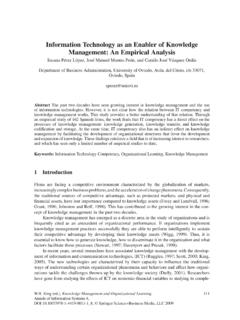Transcription of Innovation and Knowledge Creation
1 SECI Framework for Organizational Knowledge Creation Innovation and Knowledge Creation There are two major aspects to Innovation the development of ideas and Knowledge on the one hand, and the concrete implementation of them on the other. Knowledge Creation in organisations is therefore a central tenet of Innovation and must be well understood by anyone looking for ways to stimulate Innovation . This paper provides an overview of the predominant theory of organisational Knowledge Creation . This was first described comprehensively in the book The Knowledge Creating Organisation' by Nonaka and Takeuchi in 1995, but with its roots in an earlier HBR article from 1986 entitled The New New Product Development Game'. This paper introduces the analogy of the game of rugby for team based Knowledge Creation and first uses the word scrum which was later picked up an used to name what is now the most widely used agile method.
2 So agile and Innovation have had a common root from their earliest days. The ability of an organisation to create new Knowledge is essential to its Innovation capability [1-5]. Nonaka, Toyama et al. [6] go further stating that The raison d'etre of a firm is to continuously create Knowledge , Drucker [7] states that Knowledge is the only meaningful resource while Adler [8] proposes that Knowledge Creation . reaches into the heart of the process of technological Innovation . Other research has demonstrated the relationship of Knowledge management on organisational competencies and hence business performance. This so called Knowledge value chain includes dimensions of strategy, management and operations [9]. Research also differentiates tacit and explicit Knowledge in this regard, where it is proposed that sustainability of competitive advantage.
3 Requires resources which are idiosyncratic .. and not so easily transferable or replicable. The criteria point to Knowledge (tacit Knowledge in particular) as the most strategically important resource of the firm [10]. The SECI framework assumes that organisations are Knowledge creating entities, not merely information processing ones. This ability is necessary to be successful where there is constant change in business pressures and environment requiring continuous change and adaptation. New Knowledge is essential for such adaptation, making organisational Knowledge Creation a necessary capability. Similarly, agility at both the team and organisational level are necessary and also assume constant change. Indeed, agile ISD methods aspire to embrace' such change for competitive advantage. Nonaka Organisational Knowledge Creation In his seminal 1994 paper, Nonaka introduces a theory of how new Knowledge is created within an organisation.
4 He starts by describing how much extant theory of organisations has been dominated by the view that organisations process information, rather than creating it. However, the Creation and use of new Knowledge is central to organisations ability to innovate, and therefore this widespread view is insufficient to explain the Creation , definition and solving of problems which is Innovation . Nonaka's theory is based on the following underlying constructs: Epistemological: There exist two forms of Knowledge tacit and explicit. Ontological: Although Knowledge is formed by individuals, the interactions common within organisations can develop and refine it. Copyright 2010 AgileInnovation Limited. SECI Framework for Organizational Knowledge Creation Using these two dimensions' of Knowledge Creation , Nonaka proposes a spiral model where tacit and explicit Knowledge are in continuous dialogue through the interactions in communities of practice.
5 This leads to further development, clarification and amplification of the Knowledge . For an individual to acquire Knowledge , Nonaka proposes they must be committed'. That is, they must have an intention, an action oriented concept which forms their approach to the world. The value of information, and the Knowledge to which it can contribute, depends on the intention of the receiver, and not purely on the nature of the information itself. Therefore, the perception, context and prior Knowledge of the individual affects the possibility and form of meaning derived from it. Additionally, autonomy at both individual and group level is essential to provide the freedom to absorb new Knowledge this does not need to be absolute freedom, but reflect a minimum critical specification' [11]. And lastly, Knowledge Creation requires fluctuation' whereby there are discontinuities in the interaction of an individuals Knowledge with their perceived reality, leading to re-evaluation of assumptions underlying their current Knowledge .
6 Such breakdowns or contradictions therefore contribute to the Creation of new Knowledge . With these factors in place, Nonaka postulates a spiral of Knowledge ' whereby Knowledge is converted through 4 modes from explicit, declarative form to tacit, procedural form and vice-versa. Furthermore, the act of converting from one form to the other are complementary, leading to the Knowledge expanding over a period of time. Socialisation: Representing conversion from tacit to alternate tacit forms, this can occur through shared experience (for example apprenticeship), can rarely be achieved through abstracting Knowledge into an external form, and can occur without language. Externalisation: The use of metaphors to convert tacit Knowledge to explicit form writing of poetry could be regarded as an example of this whereby Copyright 2010 AgileInnovation Limited.
7 SECI Framework for Organizational Knowledge Creation complex and nuanced Knowledge is transferred through metaphor to an explicit form. Combination: By combining multiple externalised Knowledge sources through socialisations such as meetings and conversations, this mode allows combining of explicit Knowledge to create new Knowledge . Internalisation: Converting explicit Knowledge to a tacit form reflects the traditional view of learning and is associated with action' based on the newly acquired Knowledge . Nonaka's model rejects what he calls the mechanistic view of the organisation, whereby intervention in the form of training is required to bring about double loop learning and therefore Innovation . This is related to the information processing' view of the organisation, whereas continual Creation of Knowledge is built into the concept of an organisation as a Knowledge creator.
8 Conceptualisation is a core element of creativity, and therefore Innovation . Conceptualisation is supported by face to face communication which allows for the co-development of ideas. Dialectic intercourse in temporary and multi-faceted dialogues where participants can express their own ideas freely and openly, affirming and negating these in mutually constructive ways, leads to a synthesis of new Knowledge . To allow such rich interaction requires a redundancy of information on behalf of the participants, which allows learning by intrusion' but can also limit diffusion of new perspectives to more promising directions. This effect can reduce information overload and the pursuit of less productive ideas. Such dialectic dialogue also supports more radical Innovation by supporting what [12] calls abduction. He argues deduction and induction are reasoning processes that can lead to revisions or extensions of pre-existing concepts, whereby abduction involves lateral extension through the use of tacit Knowledge and metaphors to arrive at more radical, and potentially meaningful, perspectives.
9 Moving from concepts to crystalisation involves internalisation of Knowledge within the organisation. This is a cooperative activity, potentially involving a wide scope of personnel and functions, and even extending into the external value network. Experimentation can result in refinement or abandonment of the concept. Overlapping of roles facilitated by information redundancy leads to a rugby-style' activity rather than a linear pass the baton' process involving distinct specialisations and demarcations. Empirical evidence shows this leads to faster product development in Japanese firms. One potential downside is confusion caused through changing requirements though speed of execution can mitigate this. In developing a context for organisational Knowledge Creation , [13] five enabling conditions are proposed. Three of these - intent, autonomy and fluctuation are derived from earlier work but are further expanded on while two new conditions.
10 Information redundancy and requisite variety - are introduced. These five enablers are described in further detail below. 1. Organisational intent reflects the organisations aspiration to its goals. Intent implies a collective commitment to a certain strategy and such commitment is essential to any human Knowledge Creation activity. The value of Knowledge is only valid in relation to the intent. Therefore, strategic intent, often expressed as organisational vision, directs Knowledge creating efforts in support of the goals of the business. This can be operationalised as a set of strategic technology areas which support existing or emerging products and Copyright 2010 AgileInnovation Limited. SECI Framework for Organizational Knowledge Creation services Knowledge Creation within these areas are therefore aligned with the intent of the organisation.





